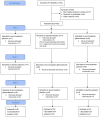Glibenclamide Posttreatment Does Not Inhibit Levcromakalim Induced Headache in Healthy Participants: A Randomized Clinical Trial
- PMID: 36763326
- PMCID: PMC10121935
- DOI: 10.1007/s13311-023-01350-y
Glibenclamide Posttreatment Does Not Inhibit Levcromakalim Induced Headache in Healthy Participants: A Randomized Clinical Trial
Abstract
Intravenous infusion of ATP-sensitive potassium channel (KATP) opener levcromakalim causes headache in humans and implicates KATP channels in headache pathophysiology. Whether KATP channel blocker glibenclamide inhibits levcromakalim-induced headache has not yet been elucidated. We aimed to investigate the effect of posttreatment with glibenclamide on levcromakalim-induced headache in healthy participants. In a double blind, randomized, three-arm, placebo-controlled, crossover study, 20 healthy participants were randomized to receive 20 mL of levcromakalim (0.05 mg/min (50 mg/mL)) or 20 mL placebo (isotonic saline) intravenously over 20 min followed by oral administration of 10 mg glibenclamide or placebo. Fifteen participants completed all three study days. The primary endpoint was the difference in incidence of headache (0-12 h) between glibenclamide and placebo. More participants developed headache on levcromakalim-placebo day (15/15, 100%) (P = 0.013) and levcromakalim-glibenclamide day (13/15, 86%) compared to placebo-placebo day (7/15, 46%) (P = 0.041). We found no difference in headache incidence between levcromakalim-placebo day and levcromakalim-glibenclamide day (P = 0.479). The AUC0-12 h for headache intensity was significantly larger in levcromakalim-placebo day and levcromakalim-glibenclamide day compared to placebo-placebo day (106.3 ± 215.8) (P < 0.01). There was no difference in the AUC0-12 h for headache intensity between the levcromakalim-placebo day (494 ± 336.6) and the levcromakalim-glibenclamide day (417 ± 371.6) (P = 0.836). We conclude that non-specific KATP channel inhibitor glibenclamide did not attenuate levcromakalim-induced headache in healthy volunteers. Future studies should clarify the involvement of the distinct isoforms of sulfonylurea receptor subunits of KATP channels in the pathogenesis of headache and migraine.
Keywords: Adenosine triphosphate-sensitive potassium channel; Cromakalim; Humans; KATP-channel; Migraine.
© 2023. The Author(s).
Conflict of interest statement
LK, MMK, and CAWN report no conflicts of interests. MA has received consulting fees and honoraria for lectures/presentations from AbbVie, Allergan, Amgen, Eli Lily, Lundbeck, Novartis, and Teva. MA has also received personal payments for participating on data Safety Monitoring Board or Advisory Board for AbbVie, Amgen, Eli Lily, Lundbeck, and Novartis.
Figures





Similar articles
-
Effect of KATP channel blocker glibenclamide on levcromakalim-induced headache.Cephalalgia. 2020 Sep;40(10):1045-1054. doi: 10.1177/0333102420949863. Epub 2020 Aug 17. Cephalalgia. 2020. PMID: 32806954 Clinical Trial.
-
Levcromakalim, an Adenosine Triphosphate-Sensitive Potassium Channel Opener, Dilates Extracerebral but not Cerebral Arteries.Headache. 2019 Oct;59(9):1468-1480. doi: 10.1111/head.13634. Epub 2019 Sep 18. Headache. 2019. PMID: 31535367 Clinical Trial.
-
Opening of ATP-sensitive potassium channels causes migraine attacks: a new target for the treatment of migraine.Brain. 2019 Sep 1;142(9):2644-2654. doi: 10.1093/brain/awz199. Brain. 2019. PMID: 31292608 Clinical Trial.
-
ATP-Sensitive Potassium Channels in Migraine: Translational Findings and Therapeutic Potential.Cells. 2022 Aug 4;11(15):2406. doi: 10.3390/cells11152406. Cells. 2022. PMID: 35954249 Free PMC article. Review.
-
Latest Insights into the Pathophysiology of Migraine: the ATP-Sensitive Potassium Channels.Curr Pain Headache Rep. 2020 Dec 3;24(12):77. doi: 10.1007/s11916-020-00911-6. Curr Pain Headache Rep. 2020. PMID: 33270149 Review.
Cited by
-
Animal Models of Chronic Migraine: From the Bench to Therapy.Curr Pain Headache Rep. 2024 Nov;28(11):1123-1133. doi: 10.1007/s11916-024-01290-y. Epub 2024 Jul 2. Curr Pain Headache Rep. 2024. PMID: 38954246 Review.
References
Publication types
MeSH terms
Substances
LinkOut - more resources
Full Text Sources

